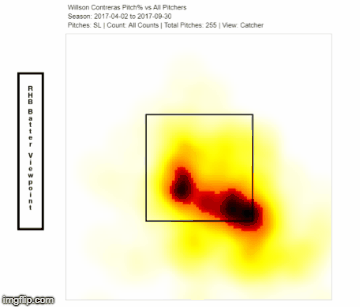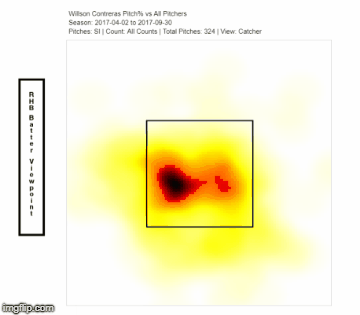What Went Wrong: Willson Contreras
The fantasy community expected big things from Willson Contreras in 2018. While Gary Sanchez was the consensus No. 1 catcher overall on draft day, Contreras was usually the second or third catcher off the board, getting drafted roughly on a par with Buster Posey. In 2017 — Contreras’ first full season in the majors — he helped owners with batting average (.276), home runs (21) and RBIs (74), which is a rare combination for a catcher. If not for missing time with a hamstring injury and an oddly-low total of 50 runs, he would have offered even more.
As a 25-year-old set to hit in the heart of a potent Cubs lineup, Contreras seemed like nearly a sure thing to finish the 2018 season as one of the top three catchers in fantasy. Even with Sanchez and Posey struggling, Contreras wound up ranking just 11th in Roto value (per ESPN), three spots behind Posey.
We could be reassured if this had simply been a case of Contreras wearing down over the course of the season or him overcoming a slow start, but he never really got on track. Through May 7, Contreras was batting .230 with one home run, and among hitters who had accumulated at least 100 plate appearances, he was in the bottom 10 percent in hard contact rate. Then he embarked on a three-game mini-streak in which he went 10 for 15 with three home runs, three doubles and two triples. This, however, was not the start of a resurgence. From May 13 forward, Contreras hit .237 with six home runs over 402 plate appearances.
From the get-go, Contreras did not have the same power he showed in his first two seasons. During his initial cold stretch, it looked as if he was trading off power for improved contact skills. Through his first 29 games — right up until the mini-streak — Contreras had an 18.1 percent strikeout rate and an 11.2 percent swinging strike rate. Those were clear upgrades from his 2017 marks of 22.9 percent and 13.5 percent, respectively.
Then not only did Contreras cease to show improved contact skills, but his contact indicators were actually worse than they were the season before. Over his final 106 games, he compiled a 24.4 percent strikeout rate and 13.7 percent swinging strike rate. Despite accruing 116 more plate appearances more than he did in 2017, Contreras hit only 10 home runs with 54 RBIs and 50 runs in 2018, and he batted just .249.
Contreras was substantially worse in most respects in 2018 than he had been previously, but he could still do some damage against four-seam fastballs. His .351 wOBA versus four-seamers was only 13 points lower than the mark he achieved in 2017. Much of his decline in power can be tied to his struggles against sliders. After posting a 23.1 percent HR/FB against the pitch in 2017, he nearly sliced that rate in half — to 12.0 percent — in 2018. Strangely, Contreras’ difficulties in making contact were driven by a surging SwStr% on sinkers, which is generally the easiest pitch to connect with. His SwStr% on sinkers in 2017 was just 4.1 percent, but this season, it rose to 5.7 percent.
In a recent piece for The Athletic, Sahadev Sharma surmised that Contreras may have been bothered by not having signed a contract extension as well as affected by the ongoing turmoil in his native Venezuela. Adjustments by opposing pitchers may have played a role in Contreras’ difficulties as well. His decline in HR/FB on sliders could be at least partially explained by the fact that pitchers were throwing sliders to Contreras far less often on the inner half of the strike zone, as shown in the heatmaps below. Both this year and last, Contreras hit for less extra-base power on pitches that were located towards the outer edge of the zone.
Similarly, we can explain Contreras’ increased SwStr% on sinkers by looking at changes in location. He may have had more trouble making contact with the pitch, given that opposing pitchers were locating in less often in or near the heart of the strike zone.
Whether Contreras was impacted by off-the-field concerns or by adjustments made by pitchers or some other set of factors, his relative youth offers us a reason to hope for a rebound or maybe even a breakout. That said, when I was faced with looking to fill my catcher slot in the currently-ongoing Pitcher List Experts Mock, I used my Round 11 pick to select Wilson Ramos, even though Contreras was still available. Even though Ramos is nearly five years older with a far more extensive injury history, I felt more confident in his ability to deliver 15-to-20 home runs with a high batting average. While we can project that Contreras will be an elite fantasy catcher in 2019, we can see that Ramos has been better at making contact and more consistent at making hard contact over the last three years.
It’s far from a given that Contreras will be a top three catcher this coming season. Even if owners prefer Contreras to Ramos, neither catcher should be anywhere close to the consensus Top Two of J.T. Realmuto and Sanchez in ADP.
Al Melchior has been writing about Fantasy baseball and sim games since 2000, and his work has appeared at CBSSports.com, BaseballHQ, Ron Shandler's Baseball Forecaster and FanRagSports. He has also participated in Tout Wars' mixed auction league since 2013. You can follow Al on Twitter @almelchiorbb and find more of his work at almelchior.com.


You almost never get a good value drafting a catcher in the first ten rounds.
What do you mean? Gary Sanchez was a consensus 3rd/4th rounder in 12 team leagues and that worked out… wait, never mind.
Relative to position, the difference between the value of the #1 projected catcher and the #12 projected catcher is larger than the difference between the #1 project player and #12 projected player at most other position.